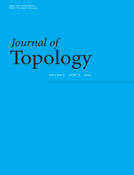
Journal of Topology
Scope & Guideline
Advancing Mathematical Frontiers in Topology
Introduction
Aims and Scopes
- Algebraic Topology:
Research in algebraic topology, including studies on homotopy groups, cohomology theories, and their implications for various mathematical structures. - Geometric Topology:
Exploration of topological properties and structures of manifolds, particularly in relation to low-dimensional topology and 3-manifolds. - Symplectic and Contact Topology:
Studies that integrate symplectic geometry and topology, focusing on contact structures and their applications in dynamical systems. - Homological and Cohomological Methods:
Utilization of homological and cohomological approaches to address problems in topology, including Floer homology and its applications. - Representation Theory and Group Actions:
Investigation of group actions on topological spaces and their representations, particularly in the context of mapping class groups and surface groups. - Higher Dimensional Topology:
Research on topological features in higher dimensions, including the study of higher homotopy groups and topological field theories. - Interdisciplinary Applications:
Application of topological methods to other fields such as mathematical physics, algebraic geometry, and combinatorial topology.
Trending and Emerging
- Floer Homology and Its Applications:
An increasing number of papers are exploring the applications of Floer homology in various contexts, particularly in symplectic topology and low-dimensional topology. - Higher Dimensional and Homotopy Theories:
Research has shifted towards higher-dimensional topology, with a focus on homotopy theory and related constructs, reflecting a growing interest in understanding structures beyond classical dimensions. - Representation Stability and Group Actions:
The analysis of representation stability in relation to various groups, including mapping class groups, is gaining prominence as researchers seek to understand stability phenomena in topology. - Noncommutative Geometry and Topology:
Emerging interest in the interplay between noncommutative geometry and topology is noted, with researchers investigating how these fields can inform and enrich each other. - Topology and Mathematical Physics Connections:
There is a noticeable trend of research that bridges topology and mathematical physics, particularly in areas like topological field theories and their implications in quantum physics. - Applications of Algebraic and Geometric Techniques:
A growing focus on using algebraic and geometric methods to solve topological problems indicates a trend towards interdisciplinary approaches, enriching the field with new perspectives.
Declining or Waning
- Classical Knot Theory:
While knot theory remains a fundamental aspect of topology, recent publications suggest a waning focus on classical results and basic knot invariants, possibly due to the rise of more complex and computational approaches. - Basic Manifold Classification:
There appears to be a decreasing emphasis on traditional classifications of manifolds, as researchers gravitate towards more intricate structures and invariants that offer deeper insights into manifold topology. - Elementary Topological Constructs:
The study of simpler topological constructs and their properties seems to be less prominent, with researchers favoring advanced techniques and applications in their investigations. - Local Properties of Spaces:
Research focused on local topological properties, such as local connectedness or local compactness, has diminished in favor of global or asymptotic properties that yield more comprehensive results.
Similar Journals

Algebraic and Geometric Topology
Unveiling New Dimensions in Algebraic and Geometric StudiesAlgebraic and Geometric Topology, published by Geometry & Topology Publications, is a premier journal dedicated to the fields of algebraic and geometric topology. With its ISSN of 1472-2739 and a commendable Q1 ranking in 2023, this journal serves as a vital resource for top-tier research, showcasing groundbreaking developments and fostering discussions among mathematicians globally. Operating since 2007 and continuing through 2024, the journal is positioned within the United States and aims to deliver open access to the latest findings, promoting collaboration and innovation. As a significant contributor to the mathematical landscape, Algebraic and Geometric Topology appeals not only to researchers and professionals, but also to students eager to explore the rich interplay between algebra and topology, making it an essential read for anyone involved in advanced mathematical studies.

Revista Matematica Complutense
Empowering Researchers through Quality Mathematics PublicationsRevista Matematica Complutense is a prestigious peer-reviewed journal published by SPRINGER-VERLAG ITALIA SRL, specializing in the field of mathematics. With its ISSN 1139-1138 and E-ISSN 1988-2807, the journal plays a vital role in disseminating high-quality research and fostering academic discussion within the mathematics community. Recognized for its rigorous selection process, the journal has achieved impressive rankings, holding a Q1 quartile status in the miscellaneous mathematics category as of 2023 and ranking #94 out of 399 in general mathematics according to Scopus, placing it within the 76th percentile. With a publication timeline spanning from 2008 to 2024, the Revista Matematica Complutense continues to serve as an essential resource for researchers, professionals, and students alike. Although it does not currently offer open access, the journal remains committed to advancing mathematical knowledge and providing a platform for innovative research across various mathematical disciplines.
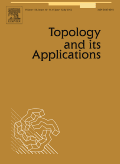
TOPOLOGY AND ITS APPLICATIONS
Pioneering Insights in Topology and Its ApplicationsTopology and Its Applications is an esteemed journal within the field of mathematics, specifically focusing on topology and its various applications. Published by Elsevier, it serves as a significant platform for researchers, professionals, and students interested in the intersection of geometry and topology. The journal has been operational since 1980 and continues to contribute to advancements in the field with its broad scope that encompasses theoretical developments and practical applications. With an impact factor that reflects its importance in the academic community, it currently holds a Q3 ranking in Geometry and Topology as per the 2023 category quartiles. The journal is indexed in Scopus, ranking #59 out of 106 in its category, which places it within the 44th percentile among other publications. Although it does not offer open access, it remains a vital resource for those engaged in cutting-edge topology research. Researchers looking to engage with innovative studies and contribute to ongoing discussions in this dynamic field will find this journal indispensable.

ADVANCES IN GEOMETRY
Pioneering Research for a Deeper Understanding of GeometryADVANCES IN GEOMETRY is an esteemed journal dedicated to the dissemination of innovative research in the field of geometry and topology. Published by WALTER DE GRUYTER GMBH, this journal serves as a vital platform for researchers and practitioners from around the globe, reflecting the latest advancements and stimulating critical discussions in the subject. With an ISSN of 1615-715X and an E-ISSN of 1615-7168, it enjoys a reputable standing, evidenced by its classification in the Q3 category of the geometry and topology domain according to 2023 metrics. Although the journal operates under standard access options, it is committed to fostering scholarly communication and raising the visibility of high-quality research. The journal's impact on the field is underscored by its Scopus rank of #77 out of 106, placing it in the 27th percentile. Since its inception in 2001, ADVANCES IN GEOMETRY has continually blossomed, promising a convergence of ideas and methodologies that drive forward the understanding of geometric theory. This journal is essential reading for those eager to stay at the forefront of geometry and topology research.

Journal of Homotopy and Related Structures
Exploring the Depths of Mathematical StructuresJournal of Homotopy and Related Structures is a distinguished academic journal published by Springer Heidelberg, specializing in the fields of algebra, number theory, geometry, and topology. With a focus on the intricate relationships and structures within these disciplines, the journal aims to facilitate the dissemination of original research and provide a platform for scholarly exchange among mathematicians. Since its inception in 2012, the journal has positioned itself in the Q2 category for both Algebra and Number Theory and Geometry and Topology in 2023, reflecting its growing influence and commitment to high-quality publications. Although it operates under a subscription model, the research published in this journal is highly cited, contributing to its notable rankings—#57 in Geometry and Topology and #65 in Algebra and Number Theory on the Scopus index. This journal is an essential resource for researchers, professionals, and students who wish to stay updated with the latest advancements and trends in homotopy theory and related mathematical structures.

Homology Homotopy and Applications
Unlocking New Dimensions in Mathematical SciencesHomology Homotopy and Applications is a prestigious peer-reviewed journal published by INT PRESS BOSTON, INC, dedicated to advancing the field of mathematics, particularly within the realms of algebraic topology, homological algebra, and their applications. With an impressive Q1 classification in the mathematics category for the year 2023, this journal serves as a crucial platform for researchers, professionals, and students aiming to disseminate their findings in a rapidly evolving discipline. Although open access options are not currently available, the journal retains significant value with its rigorous selection process and high-impact studies. The journal invites submissions that explore theoretical developments as well as practical applications that bridge homology and homotopy theories, thus contributing to the broader scientific community from its base in the United States. With convergence covering years from 2001 to 2024, Homology Homotopy and Applications continues to be a vital resource for fresh insights and groundbreaking research in mathematical sciences.

Groups Geometry and Dynamics
Transforming Mathematical Thought Through Open AccessGroups Geometry and Dynamics is a pioneering open-access journal published by the European Mathematical Society (EMS), dedicated to advancing the fields of discrete mathematics, combinatorics, geometry, and topology. With its ISSN 1661-7207 and E-ISSN 1661-7215, this journal serves the global mathematical community by providing a platform for high-quality research and insightful discussions. Established in 2009 and showcasing innovative findings through to its converged years of 2024, it has achieved notable rankings, securing a Q1 category in Discrete Mathematics and Combinatorics and a Q2 in Geometry and Topology, indicating its substantial impact within these domains. The journal's presence in Scopus ranks underscores its significance, positioned within the top echelons of its categories. As an open-access publication since 2021, it enhances accessibility and visibility for researchers, professionals, and students alike. Located in Berlin, Germany, and backed by a commitment to fostering collaborative research, Groups Geometry and Dynamics aims to be a leading voice in the mathematical discourse, challenging and inspiring inquisitive minds in the ever-evolving world of mathematics.
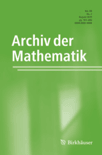
ARCHIV DER MATHEMATIK
Uncovering New Dimensions in Mathematical ResearchARCHIV DER MATHEMATIK is a distinguished journal published by SPRINGER BASEL AG, renowned for its contributions to the field of mathematics. Established in 1948 and continuing its legacy through to 2024, the journal provides a platform for innovative research and scholarly articles that push the boundaries of mathematical theory and application. With an ISSN of 0003-889X and an E-ISSN of 1420-8938, it holds a reputable position within the academic community, reflected by its Q2 ranking in the 2023 Mathematics (Miscellaneous) category. Despite not being an open access publication, ARCHIV DER MATHEMATIK remains accessible to a global audience through various databases, ensuring the dissemination of high-quality research. The journal’s commitment to enhancing mathematical discourse makes it an essential resource for researchers, professionals, and students seeking to expand their understanding of this vital discipline.
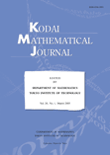
Kodai Mathematical Journal
Empowering Researchers with Rigorous Mathematical DiscourseKodai Mathematical Journal is a distinguished publication dedicated to advancing the field of mathematics, particularly in miscellaneous areas. Established in 1949, this esteemed journal has been a reputable source for researchers and practitioners who seek to contribute to the rich landscape of mathematical knowledge. Published by KINOKUNIYA CO LTD, the journal is based in the academic environment of Tokyo Institute of Technology and serves a global audience with rigorous and insightful research articles. Despite its current Q3 quartile ranking in the Scopus Mathematics category, which reflects its niche but impactful contributions, the journal is poised for growth; the convergence of traditional and novel mathematical techniques promises to enhance its relevance further. Researchers, professionals, and students are encouraged to engage with the rich content of the journal, aimed at fostering collaboration and nurturing innovation in the mathematical community. While currently not available as Open Access, Kodai Mathematical Journal remains a critical resource for those passionate about mathematics and its applications.
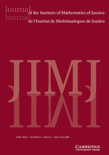
Journal of the Institute of Mathematics of Jussieu
Exploring Innovative Ideas in Mathematical SciencesJournal of the Institute of Mathematics of Jussieu, published by Cambridge University Press, is a leading academic journal that has established itself as a vital resource in the field of mathematics. With an impressive impact factor and a ranking in the top quartile (Q1) of miscellaneous mathematics, the journal serves as a platform for high-quality research from both established scholars and emerging researchers. Spanning from 2002 to 2024, the journal aims to foster collaboration and innovation in the mathematical community by publishing original research articles, reviews, and critical discussions on a wide range of mathematical topics. Although the journal does not offer open access, it remains widely accessible through various academic institutions and libraries, ensuring that critical advancements in mathematics are shared with a global audience. Located in the United Kingdom at the prestigious Cambridge campus, the journal reflects the rigorous standards of its publisher and the rich academic tradition of its home institution.